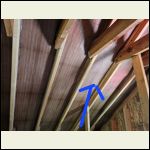| << . 1 . 2 . |
| Author |
Message |
snobdds
Member
|
# Posted: 5 Nov 2023 09:29am - Edited by: snobdds
Reply
It's venting an air gap, which is 1.5 inches, by 14.5 inches, by 20 feet.
3 one inche holes are more than enough, and maybe a little bit much for the amount of air needed for displacement.
Properly venting a gambrel roof is one down fall of that roof design. It's possible, but not easy to accomplish correctly. Like in the above pictures, even with soffit venting, how do you vent that? The soffits are outside of roof deck as an add on. In that case, spray foam is about the only option.
|
|
travellerw
Member
|
# Posted: 5 Nov 2023 11:34am
Reply
Quoting: snobdds Like in the above pictures, even with soffit venting, how do you vent that?
The air channel that is made up of foam insulation extends down into the soffit. Its a clear path up the soffit all the way to the peak. I was trying to find a picture, but I don't have one that shows it well, so I drew a crude representation.
We glued small pieces of foam to the underside of the sheeting (in this picture it looks like they are blocking the flow, but in reality they are only about 1 inch wide in a 16 inch wide bay.) These small blocks stop the foam from being pressed all the way up to the sheeting in the later steps. The foam is then cut to fit in the bay (gray layer). The joints are taped (red). After that the pink insulation (R21 worth). Then plastic vapor barrier. Finally finishing (drywall in my case).
Hope that is clearer.
|
|
geobuild
Member
|
# Posted: 5 Nov 2023 03:06pm - Edited by: geobuild
Reply
....
|
|
gcrank1
Member
|
# Posted: 5 Nov 2023 08:20pm
Reply
That looks like it should work 
|
|
ICC
Member
|
# Posted: 5 Nov 2023 09:22pm - Edited by: ICC
Reply
Quoting: gcrank1 And there is no downside to having more than the calc min
It is better to have more than the minimum. However, there is a very definite point of diminished returns. See below a ways....
Quoting: snobdds Quoting: ICC However, is 20% of a straight line meaningful when one is considering ventilation area, a 2 dimensional measurement? Yes. Don't confuse venting an entire attic with venting a roof deck of a cathedral ceiling
I stand corrected. Venting a cathedral ceiling is different from venting a non-conditioned attic space. Properly venting a cathedral ceiling is more complicated than applying the general-purpose 1:150 (or 1:300 in some special cases) ratio commonly found in the IRC, although following that rule will generally pass any code inspections.
I should note that I do find cathedral ceilings visually pleasing while at the same time, I don't like them because they can be a source of energy inefficiencies as well as other problems. When I was working I built many, following plans approved by building code/permit departments. Most plans were drawn by architects and/or engineers.
I asked an engineer. (A relative; 23 years experience) According to her, the slope of the roof/ceiling is one factor in determining proper ventilation. What works best also is dependent on the R-value of the insulation and the size of the roof, specifically the length of the rafter bay from soffit to ridge.
Cold climates may have issues with ice damming along eves, even if the 1:150 rule has been followed. That is more of a concern with shallower potch roofs. She showed me a few graphs and tables using her design software.
A well-insulated (R38 to R40) 12:12 pitch (45 degrees) roof could use an air space of 1" height with a rafter bay length of 15 ft. That would require an air inlet of 4.3 sq. in. per lineal foot along the eve. If the rafter bay had a length of 30 ft. an air space 1-1/2" high would work along with an air inlet area of 5 sq. in. per lineal foot along the eve. Those air inlet areas would need an equal area at the ridge/peak. Those values would be for each half of a standard gable roof.
The graph for the airway height flatlines once the height reaches 1" or 1-1/2" in the two examples above. So making the air space larger ceases to improve venting once the best flow is reached.
Quoting: travellerw Its a clear path up the soffit all the way to the peak. I was trying to find a picture, but I don't have one that shows it well, so I drew a crude representation.
That appears to be a well-thought-out method, depending on the actual air space heights and size of the inlet and exit venting.
Some of the better cathedral ceilings are designed using a raised-heel scissors truss. Maybe a 12:12 exterior slope with a 9 or 10:12 inside. The raised heel allows for good insulation right out to the eve walls and is still visually pleasing. Or build the roof with the insulation on top of the roof decking (foam panels). No venting is required when the R-value matches the climate zone.
|
|
snobdds
Member
|
# Posted: 6 Nov 2023 11:40am
Reply
Here is how I did mine. I have highlighted the spacers for the rigid foam. I have also highlighted the one we finished with the sides of the prodex vapor barrier attached to the sides of the rafter with pine trim.
My dad likes the look of the exposed rafters and prodex fake wood look. It's ok, but I will one day cover it with tongue and grove pine.
It made a huge difference in keeping in the heat when it was cold and keeping the heat out when it's warm.
Inked20230814_113356.jpg
| 
20231106_093106.jpg
|  |  |
|
|
ICC
Member
|
# Posted: 6 Nov 2023 08:57pm
Reply
I too, would prefer to see a more finished appearance to the ceiling with all the framing hidden. 
-izzy
|
|
snobdds
Member
|
# Posted: 6 Nov 2023 11:24pm
Reply
Believe it or not, it was a lot of work. A lot of tedious work.
I wish there was a better way to do it, but I don't see one. I did the spay foam kit route on the floor. Although it was faster and it worked well, it was super messy. So messy I vowed never to use it again,
|
|
|
hinterlander
Member
|
# Posted: 10 Nov 2023 09:02am - Edited by: hinterlander
Reply
Quoting: snobdds 3 one inche holes are more than enough, and maybe a little bit much for the amount of air needed for displacement.
So Im clear; In your pic, you hadn't drilled the holes yet?
Mine is a pre-built, so my roof meets up and pretty much stops at the wall with a bit of over-hang on the outside with a rain gutter. That being said, I think my best option (short of dismantling the entire roof and doing what you or travellerw did) is to cut small slits (1"x4") in between each rafter right at that first angle of the roof. Then use some kind of venting material to stop snow drifting (which works for ridge vents, correct?), because there isn't a lot of over-hang there either (maybe 3"-4")
|
|
| << . 1 . 2 . |

